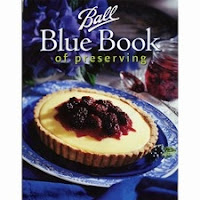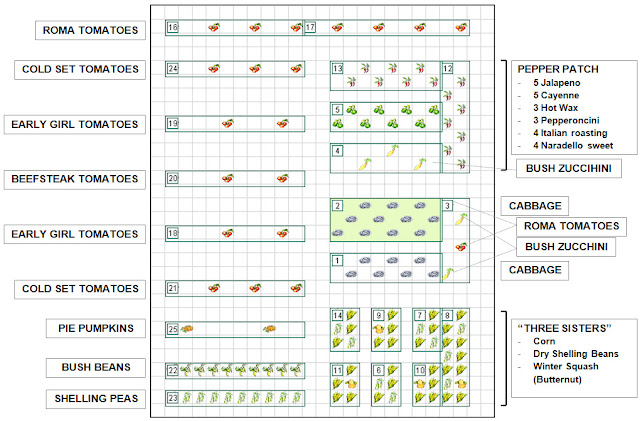 Last September, with twenty or so pounds of cabbage fresh-picked from the garden sitting on my kitchen counter, I opened the Ball Blue Book of Preserving (one of the few absolutely essential tools for anyone even thinking about preserving their own food). Though this was my first foray into vegetable fermentation, I had canned things before - dilly beans (p. 54) and whole pears in syrup (p. 20), to zesty salsa (p. 80) and seasoned tomato sauce (p. 23) - so I wasn't really expecting any surprises. Then, I opened to page forty-six and saw the following:
Last September, with twenty or so pounds of cabbage fresh-picked from the garden sitting on my kitchen counter, I opened the Ball Blue Book of Preserving (one of the few absolutely essential tools for anyone even thinking about preserving their own food). Though this was my first foray into vegetable fermentation, I had canned things before - dilly beans (p. 54) and whole pears in syrup (p. 20), to zesty salsa (p. 80) and seasoned tomato sauce (p. 23) - so I wasn't really expecting any surprises. Then, I opened to page forty-six and saw the following:
Sauerkraut
Ingredients:
- 20 pounds of cabbage
- 3/4 cup canning salt
... and that was it. A vinegar lover myself, I actually couldn't believe that the rich sour taste I'd enjoyed in several varieties of store-bought sauerkraut was truly the product of only these two simple ingredients. It wasn't possible, right?
So like any good child born after 1985, I indulged my skepticism by going straight to the best source of popular commentary on all things great and small: Google. Typing in something along the lines of sauerkraut ingredients, I found a plethora of blogs, forums, and chat groups who had covered this very concern. After a quick scan of a few separate pages (you've got to be sure to cross-reference sources), the issue was resolved. According to overwhelmingly popular opinion, sauerkraut is the product of cabbage, salt, and time.
 |
| 3-gallon pickling crock |
Despite my minor technological detour, I was soon back in the kitchen. Following the recipe, I shredded cabbage, wilting it in batches with a couple of tablespoons of salt, then firmly packing it into my 3-gallon Ohio Stoneware Crock (purchased at
Downtown Home and Garden in Ann Arbor, MI - an inspiring small, local business with everything you need to be both self-reliant and surprisingly gourmet). Once I could fit not even an ounce more into the crock, I covered the now juicy mixture with a
wooden sauerkraut board, some cheesecloth and set it in a disposable aluminum turkey pan on my counter (note: this type of salt brine will take the finish off most things, including my counter tops, thus the turkey pan).
That was it. No cooking. No boiling. Now all there was to do was wait three weeks, occasionally scraping a totally normal but no less slimy layer of scum off the top. That's the interestingly satisfying thing about sauerkraut. Walking by it everyday, you can smell the vegetable rotting taking place making it hard to imagine that anything even remotely edible, much less delicious, is going to come out of that immensely heavy object emitting indecent odors and hogging all of the counter top space. And then, before you know it, it's ready. Making about 9 quart-sized canning jars of the stuff and tasting fresher and crisper than store bought varieties, you've successfully engaged in a very old form of food preservation by way of fermentation.
Kinda neat, aye?
We liked our first batch of sauerkraut so much (I'd sneak spoonfuls by night when Josh was in the other room) that in early December we went to the Farmers' Market with the mission of finding some of the season's last cabbages to make another batch. Find them we did, though this batch came out with an almost sweet taste that neither Josh nor I is nearly as fond of (now I'm sneaking it into Josh's sandwiches and conveniently forgetting to put it on mine). I followed an identical process to the first batch, so the explanation that I've come up with for the difference in flavor is that frost had something to do with it. Some suggest that certain hardier vegetables be harvested after a hard frost since something about this kind of cold actually improves the taste (e.g. horseradish, brussel sprouts). These cabbages were certainly picked after a hard frost, so my admittedly imperfect theory is that this explains the fundamental taste difference.
However, because even I am not entirely convinced of this explanation (another Google search - this time for "sweet sauerkraut frost" - returned no satisfaction), I am working hard this season to find a good sauerkraut variety of cabbage since we plan to commit a sizable piece of our plot to it (about 66 square feet, twenty or so plants).
One variety we will be planting (mostly because I already have the seeds) is simply called Late/Storage green cabbage (from
Johnny Select Seeds).To hedge our bets, I've been doing yet more online forum perusing, and the consensus seems to be that late varieties are better, and among them Dutch Flathead is the best.
Though many criticize the unreliable nature of truly free and democratic knowledge bases (like the internet and, specifically, Wikipedia), I have both built confidence and taken comfort through the resources provided by open social forum. The confidence part is pretty straightforward: with the ability to do a quick double-check of the procedure, I am more willing and eager to try something new, knowing with relative certainty (or so I tell myself) that my time, energy, and precious harvest of cabbage will not be wasted through some simply avoided misstep of mine. The comfort part is a bit more complex but, essentially, I feel better knowing that others have the same or similar questions as I have, knowing that there is a network of novices who, like me, rely on others' tales of their successful (and failed) experiments to help inform my own.
 I think I've come to see that a large part of why I'm doing this online in narrative form as opposed to in a spreadsheet on my personal computer, is that I want to contribute my own small pearls of knowledge, hard gathered through ample trial and error. I am constantly working towards crafting a lifestyle that is less dependent on things and resources that are too often taken as fact and not as the conveniences they are. And almost ironically, in this process, the need for a community of people engaged in similar pursuits, for a certain type of communal wisdom becomes more apparent than ever.
I think I've come to see that a large part of why I'm doing this online in narrative form as opposed to in a spreadsheet on my personal computer, is that I want to contribute my own small pearls of knowledge, hard gathered through ample trial and error. I am constantly working towards crafting a lifestyle that is less dependent on things and resources that are too often taken as fact and not as the conveniences they are. And almost ironically, in this process, the need for a community of people engaged in similar pursuits, for a certain type of communal wisdom becomes more apparent than ever.
So, with that, I'll conclude with the wish that when life gives us cabbages, may we always be able to make sauerkraut.



















